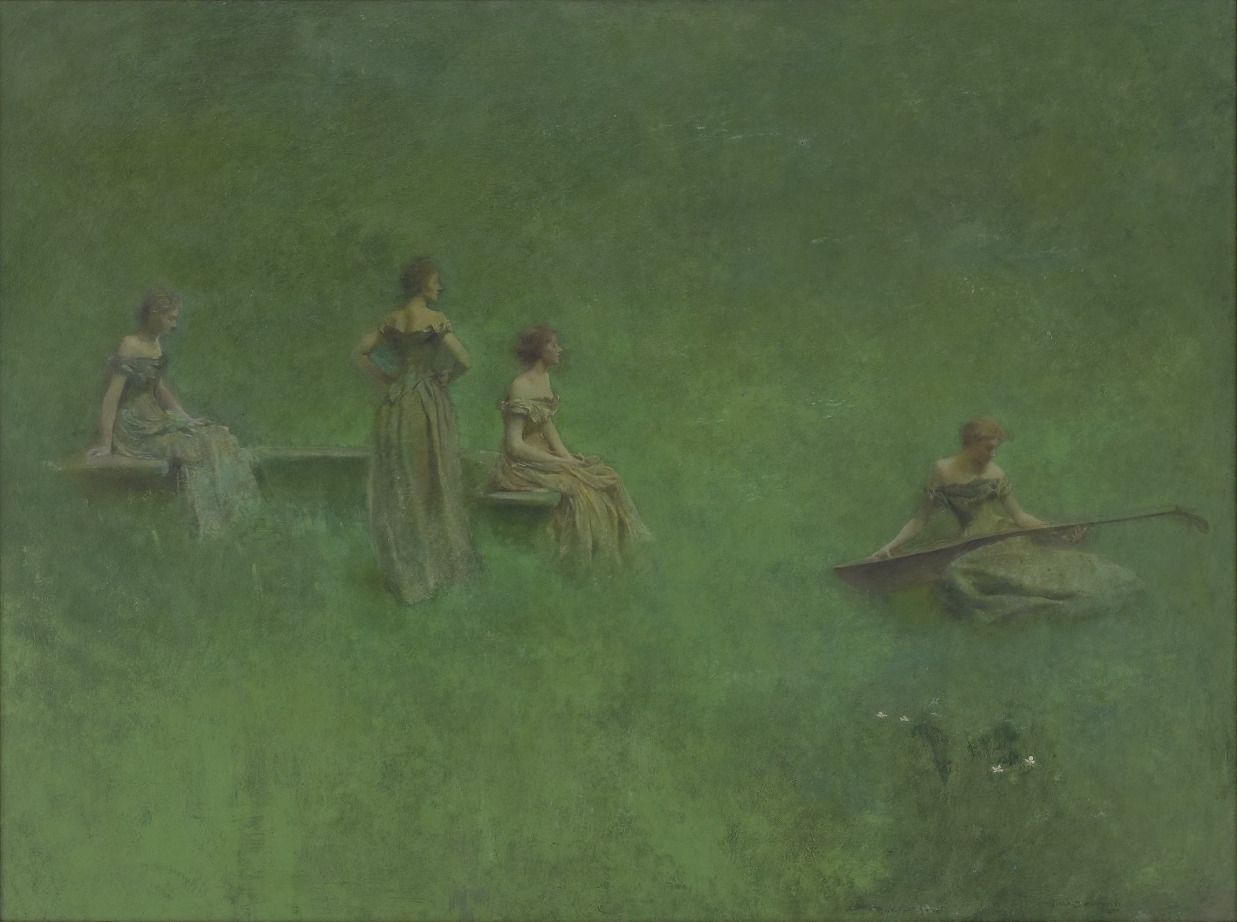meditation 18

Similarly . . .
when savoring the resonance trail
of a sustained musical tone . . .

rendered on a stringed
instrument . . .

as the tone fades
almost imperceptibly . . .

into silence . . .

the felt sense
of one's corporeal form
fades similarly
into void . . .

In the mode of galaxies circling the Pole Star or the globe of Moon, orbiting Earth, each tone of melody in Indian classical music, blossoming within its own moment of unfolding, orbits in awe of the harmonic haunt of a tonic continually voiced by a stringed drone instrument.
Any loitering note of melody fades into pure silence —into the true home of all tonic tones — the formless, nether nothingness of one's own formless form.
Notice how the above musical scale begins with the tonic note (rectangle #1), which at the zenith of the ascending scale (rectangle #13), is repeated an octave higher, and again at the nadir of the descending scale (rectangle #24).
You may also notice how each non-tonic note of melody, during its own musical moment, glides along with a yearning, an appeal, a prayer for dissolution into the spiritual mass of the tonic reverberation.
How flutelike! How dulcet! The tonic tone (#13) , , ,
▼▼⛛▼⛛▼▼
Please read Swamiji's commentary on this verse in his Manual for Self Realization (John Hughes, ed.).
Swami Lakshmanjoo and Pandit Dina Nath Muju's 1974 – 1975 translation of this verse reads as follows:
Verse 41
Similarly attend to the collective sound produced by (stringed) musical instruments. Watch the succession of sounds in it and then the ending of each note. You will become the great Void.
In Western music, the musical notation for a note, an entire composition, or an entire orchestra fading into silence is called niente.
Niente is Italian for nothingness, void, or also, for almost nothing.
Niente will often surface at the end of a score: signaling the conductor to fade to little more than a mere echo of an angel's whisper . . . the music diminishing ever so gently . . . diminuendo al niente.
The musical symbol for niente is usually written as an n or an ø.
Before Western composers came up with a way to notate them, the length of rests in music were often dictated by buildings. When groups of monks, facing each other in a reverberant chapel, intoned psalms in plainchant, they inserted a pause in the middle of a verse.
The length of this “media distinctio” was partly determined by acoustics: It prevented the next line of lyrics from getting entangled with the resonance trail of the last.
But as the musicologist Emma Hornby has pointed out, it also created a meditative space. It synchronized the community and underlined, as she writes, “the unity of the monastery breathing and singing together.” ~ Corinna da Fonseca-Wollheim, New York Times, Oct. 2, 2019
Beethoven is so often associated with images of him scowling that it’s worth remembering that he, too, was adept at the comic rest. He also mastered the mystical silence, the dramatic silence, and silence-as-sound-painting.
But what Beethoven introduced most forcefully into Western music was the explosive silence. The technique is not unlike that behind comic rests: You carry your listeners along on a train of musical thought that leads them to think they know what’s coming. Then you pull out the rug from underneath.
In the first movement of his “Eroica” Symphony, that train of thought builds up aggressive momentum, culminating in a series of slashing dissonant chords that are repeated with relentless force. Then, on the first beat of the next bar, where the ear expects either more of the same or a resolution of the harmonic tension — a void. “The loudest silence in musical literature,” the musicologists Grosvenor Cooper and Leonard Meyer call this moment.
The shock of a rest such as this one draws its power from a certain regular meter or pattern that has been set up beforehand. At an unconscious level, listeners begin to identify the pulse of the music with their own. When it drops away unexpectedly, the silence delivers a heart-stopping jolt.
Sanskrit poetics has its own so-called Eroica Moments. The peace of Shanta Rasa, for instance, can be immeasurably deepened by what a poet leaves unsaid or merely implied.
In classical Sanskrit dramaturgy, women are often portrayed with rich emotional complexity and spiritual depth. Their actions, expressions, and especially silences are rich with implied meanings.
Within relationships, implication centered on female characters because they were often the ones bearing the emotional burden. Because Indian women lived in a patriarchal society, their longing, restraint, and internal conflicts were often expressed more through suggestion than through direct speech. They were also bound by societal norms, leaving them with expressing their desires obliquely as the only option, often resorting to gesture, metaphor, or silence. A glance, a pause, or a poetic metaphor can evoke śṛṅgāra (romantic) or karuṇa (pathos) with great subtlety.
For example, in Bhavabhūti’s Uttararamacarita, Sītā’s silence and restraint speak volumes about her dignity and suffering, conveying more feeling more poignantly than can spoken dialogue.
Similarly, in Diṅnāga’s Kundamālā, the character of Sītā is surrounded by scenes of quiet implication: her exile, her pregnancy, her reunion with Rāma, all dramatized with emotional nuance and indirect expression.
Implication thus becomes a form of female power. These women act through silence, leading the narrative through suggestion, restraint, and emotional intelligence.
For this reason, feigned ignorance (mugdhatā or mānavinaya) appears as a subtle and recurring motif in Sanskrit poetics, especially in the portrayal of women. This is a deliberate aesthetic strategy often used to evoke charm, mystery, or emotional tension.
Taking it one step further, in classical Sanskrit drama and poetry, particularly in romantic contexts, women characters sometimes pretend not to understand something: usually love, desire, or social cues. This is a facet of śṛṅgāra rasa (the aesthetic of love), where emotional nuance is everything.
A heroine might feign ignorance of a lover’s intentions, creating playful tension. To maintain decorum or avoid embarrassment, in conservative settings, she might pretend not to grasp a topic. Feigned ignorance can mask deeper feelings, such as longing, jealousy, or vulnerability, while preserving dignity.
In Kālidāsa’s Abhijñānaśākuntalam, Shakuntalā often embodies this trait. Her hesitation and indirect speech suggest deeper emotions she’s not ready to express openly. In Bhavabhūti’s Mālavikāgnimitram, Mālavikā, the heroine, uses feigned ignorance to navigate courtly love and maintain her mystique. Also, many short poetic aphorisms (subhāṣita verses) celebrate the charm of a woman who “does not know” she is beautiful or loved (though the reader knows she knows).
In addition to flirtation, feigned ignorance provided Indian women with a way of expressing power. It allowed women to control the pace of emotional revelation, to protect themselves, or to test the sincerity of others. In a culture that always prized indirectness and suggestion (dhvani), this kind of subtle play was deeply admired.
There are also many compelling examples of women using implication (dhvani-like suggestion) in Sanskrit literature long before the formal theory of dhvani was codified by Ānandavardhana in the 9th century.
The tradition of subtle, indirect expression, especially through female voices, runs deep in Vedic, epic, and early poetic texts.
Vedic poetesses such as Lopāmudrā, Apālā, and Ghoṣā composed hymns in the Ṛgveda that are rich in emotional and symbolic suggestion. Lopāmudrā’s hymn to Agastya (Ṛgveda I.179) subtly implies her desire for conjugal union, cloaked in metaphysical language. She evokes love through suggestive metaphor.
Apālā, rejected by her husband due to a skin disease, prays to Indra for healing (Ṛgveda VIII.80). Her verses imply both suffering and resilience, without overt complaint.
These hymns are emotionally charged and indirect, invoking dhvani in spirit, if not in name.
In the Mahābhārata, Draupadī often speaks in silences. Her silence during her disrobing, followed by her cryptic invocation of Kṛṣṇa, is a moment of implied divine protest and moral indictment.
Sītā, in Vālmīki’s Rāmāyaṇa, uses implication masterfully. Her words to Rāma before her exile are restrained but loaded with emotional and ethical undertones.
In the Vijñāna Bhairava Tantra, Bhairavī feigns ignorance not because she actually lacks knowledge but to elicit deeper teaching, as if she needed to. This is a classic tantric motif: the feminine as the initiator through her apparent passivity.
Thus, implication, "telling it slant," as Emily Dickinson would put it, often serves as a necessary mode of expression for women in patriarchal contexts. It allows them to masterfully navigate social constraints, express agency without confrontation, and evoke deeper emotional and philosophical truths. So, know that long before dhvani was theorized, women in Sanskrit literature were already its most eloquent practitioners.
In this regard, verse 112 of the Vijñāna Bhairava Tantra stands as one of the most radical, subtle, and fundamental insights in the entire text. The verse proposes "unknowing" (ajñāna, or more precisely, the dissolution of conditioned knowing) as a direct path to the realization of Bhairava, Divine Awareness. It serves a meditative technique (yukti) wherein the practitioner floats in the ether of broken-down perception, confusion, disorientation, or illusion, as a gateway to Formless Divinity. This formative yukti forms the ground state of the tantric view that every experience, including unknowing or absence, can function as a portal to the Absolute. It’s a radical truth of the non-dual in which even the failure of cognition opens to the Sacred.
Corinna da Fonseca-Wollheim, New York Times, Oct. 2, 2019
“You cannot direct the wind — but you can adjust your sail.” ~ Arvo Pärt
To enable his commentary on this scripture to endure down through the ages, Swami Lakshmanjoo left it in two other forms:
(i) a series of videos gracing each verse, which over a few years, John Hughes of the Lakshmanjoo Academy recorded, and
(ii) Swami Lakshmanjoo's textual embodiment of the tapes, The Manual for Self-Realization: 112 Meditations of the Vijñāna Bhairava Tantra (edited by John Hughes).
Both are treasures! In each, Swamiji comments on the scripture while responding to questions from his students. Swamiji emphasizes that the video version transmits his teaching with a higher level of fidelity.

